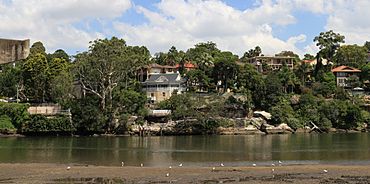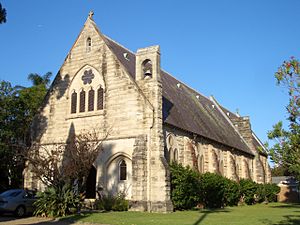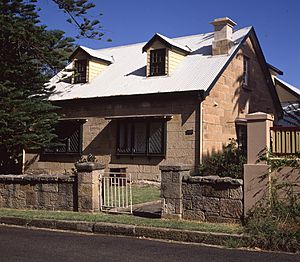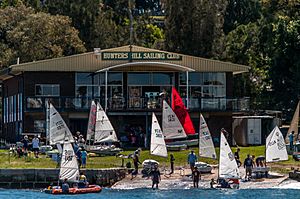Hunters Hill, New South Wales facts for kids
Quick facts for kids Hunters HillSydney, New South Wales |
|||||||||||||||
|---|---|---|---|---|---|---|---|---|---|---|---|---|---|---|---|

Hunters Hill, New South Wales
|
|||||||||||||||
| Population | 9,528 (2016 census) | ||||||||||||||
| • Density | 1,657.0/km2 (4,292/sq mi) | ||||||||||||||
| Established | 1861 | ||||||||||||||
| Postcode(s) | 2110 | ||||||||||||||
| Area | 5.75 km2 (2.2 sq mi) | ||||||||||||||
| Location | 9 km (6 mi) NW of Sydney CBD | ||||||||||||||
| LGA(s) | Municipality of Hunter's Hill | ||||||||||||||
| State electorate(s) | Lane Cove | ||||||||||||||
| Federal Division(s) | North Sydney | ||||||||||||||
|
|||||||||||||||
Hunters Hill is a suburb in Northern Sydney, New South Wales, Australia. It is about 9 kilometres north-west of the centre of Sydney. Hunters Hill is also the main office for the local council area called the Municipality of Hunter's Hill.
This suburb is located on a small piece of land that sticks out into the water, separating the Lane Cove and Parramatta Rivers. You can get to Hunters Hill by bus or by ferry.
Contents
History of Hunters Hill
The original Aboriginal name for this area was 'Mookaboola' or 'Moocooboola'. This name means meeting of waters, which makes sense because of the rivers nearby.
Hunters Hill was named after John Hunter. He was the second Governor of New South Wales from 1795 to 1800.
The area we now know as Hunters Hill was first settled in 1835. One of the very first settlers was Mary Reibey. She was known as the first female shop owner in Sydney. Mary built a small house, later called Fig Tree House, right on the Lane Cove River. A street in Hunters Hill, Reiby Street, is named after her. In the 1840s, bushrangers and people who had escaped from the prison on Cockatoo Island would sometimes hide in Hunters Hill.
Many of the first houses in the suburb were built using local sandstone. A French man named Didier Numa Joubert bought a large piece of land from Mary Reibey in 1847. He brought 70 stonemasons from Italy to build strong, beautiful houses. Hunters Hill officially became a municipality (its own local government area) on January 5, 1861. The first Gladesville Bridge was built in 1881. This bridge connected Hunters Hill to Drummoyne and the southern side of the Parramatta River.
In the early 1900s, Hunters Hill had some factories. One of these was a refinery that processed radium and uranium from 1911 to 1915. The special rock was brought over 1,200 kilometres from Radium Hill in South Australia. At that time, uranium was not as important as radium. Radium was very valuable, and the refinery could make tiny amounts of it from a lot of rock.
Historic Places in Hunters Hill
Hunters Hill has many places that are protected because of their history. These are called heritage-listed sites. Some of these include:
- 38–40 Alexandra Street: Vienna, Hunters Hill
- 12 Crescent Street: Milthorpe, Hunters Hill
- 14 Crescent Street: Hestock
- Ferry Street: The Garibaldi
- Nelson Parade: Kellys Bush Park
- 46 Ryde Road: Marika, Hunters Hill
- 2 Yerton Avenue: The Chalet
Many other buildings are also heritage-listed, meaning they are important parts of history:
- Public School including Eulbertie, Alexandra Street
- Post Office, Alexandra Street
- Town Hall, Alexandra Street
- St Ives, Crescent Street
- Anglican Church of All Saints, corner Ferry and Ambrose Streets
- Kyarra, Madeline Street
- Fig Tree House, Reiby Road
- Clifton, Woolwich Road
- Waiwera, Woolwich Road
- St Claire, Wybalena Road
- Woolwich Dock, Franki Avenue, Woolwich
Homes and Views
Hunters Hill covers an area of about 5.75 square kilometres. A big part of this, about 650,000 square metres, is made up of parks and natural areas. Most of the buildings in Hunters Hill are homes.
Because Hunters Hill is located where the Lane Cove and Parramatta Rivers meet, and close to the start of Sydney Harbour, many homes have beautiful river and harbour views. In the past, many French people lived here, so it was known as the "French Village." Hunters Hill even has a special friendship with a town near Paris, Le Vésinet, which is called a "sister city."
People of Hunters Hill
Who Lives Here?
In the 2016 census, there were 9,528 people living in Hunters Hill.
- About 69% of people were born in Australia.
- Other common birthplaces included England (4%), China (2.7%), and New Zealand (1.4%).
- Most people (76.4%) spoke only English at home.
- Other languages spoken included Mandarin (3%), Italian (1.9%), and Cantonese (1.8%).
- The most common religions were Catholic (37.4%), No Religion (23.1%), and Anglican (13.7%).
The average weekly income for households in Hunters Hill was high, at $2,700. Monthly mortgage payments were also high, around $3,500. Hunters Hill (and nearby Woolwich) was ranked as one of the wealthiest suburbs in Australia in 2016–2017.
Famous People from Hunters Hill
Many well-known people have lived in Hunters Hill, including:
- Cate Blanchett, a famous actress
- Andrew Upton, a writer
- Delta Goodrem, a singer and actress
- Kristina Keneally, a politician
- Brian McFadden, a singer
- Ann Sanders, a journalist
- Josh Hazlewood, a cricketer
- Lang Walker, a property developer
Getting Around Hunters Hill
Bus Routes
Several bus routes go through Hunters Hill:
- 252: From King Street Wharf to Gladesville
- 505: From Town Hall Station to Woolwich (during busy times)
- 506: From The Domain to Macquarie University
- 530: From Burwood to Chatswood
- 536: From Gladesville to Chatswood (during busy times)
- 538: From Gladesville to Woolwich
Ferry Services
The closest ferry stops to Hunters Hill are Valentia Street Wharf, Woolwich, and Huntleys Point.
- Huntleys Point connects to ferries that travel along the Parramatta River between Circular Quay and Parramatta.
- Woolwich connects to ferries that go to Cockatoo Island from Circular Quay.
Shopping and Services
Hunters Hill has a few shopping areas. You can find shops on the corner of Alexandra and Ferry Streets, and also along these streets and Woolwich Road.
The main shopping area is located where Ryde Road and Gladesville Road meet, near the Burns Bay Road overpass and the Hunters Hill Hotel. This area was updated in 2013.
Schools in Hunters Hill
Hunters Hill is home to several schools:
- St Joseph's College: A Catholic secondary school for boys, part of the AAGPS.
- Hunters Hill High School
- Boronia Park Public School
- Hunters Hill Primary School
- Villa Maria Primary School
Churches in Hunters Hill
There are two Catholic churches in Hunters Hill:
- Villa Maria Church in Mary Street
- St Peter Chanel in the eastern part of the suburb
Villa Maria is also the main office for the Marist Fathers in Australia. From the 1860s, it was important for their work in the Pacific. St Joseph's College also has a large chapel. The Catholic Church is connected to St Anne's Nursing Home, which is run by the Sisters of St Joseph.
Other churches include St Mark's and All Saints Anglican Churches, and Hunters Hill Congregational Church.
Sports and Recreation
The Hunters Hill Tennis Club is one of the oldest sports clubs in Australia. It started in the 1860s! Famous Australian poet Banjo Patterson played at the club in the 1890s. The club has had many champions as members. It has five grass courts, which are rare to find in Sydney today.
The Hunters Hill Rugby Union Football Club was started in 1892. They play in the New South Wales Suburban Rugby Union competition. This club has won the Kentwell Cup 8 times and the 1st Division club championship 5 times. They play their matches at Boronia Park from March to August.
Important Landmarks
Hunters Hill has a private hospital on Alexandra Street. On High Street, there is a Jewish nursing home and synagogue called the Sir Moses Montefiore Home. The historic Hunters Hill Town Hall is on Alexandra Street, close to the old post office.
The Great North Walk is a long walking trail that goes from Sydney all the way to Newcastle. This trail passes through Boronia Park. Boronia Park is a large parkland next to the water and has Aboriginal drawings that are thought to be very old, from before the first European settlers arrived.
Images for kids
-
Former Garibaldi Inn, on the corner of Alexandra and Ferry Street
-
Vienna, a heritage-listed worker's cottage















